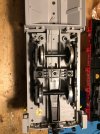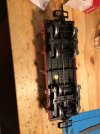Gerard
Registered
In reply #15 Rhino Chugger mentions the problem of not straighten out of the wheels after a bend.
I had the same issue with 2 axe wagons and solved it by applying a horizontal thin springsteel wire acting as a straightening spring.
In long wagons the wire is mounted in two horizontally drilled holes, one in the wheels base and the other in the wagon base structure.
In short wagons both holes can be drilled in the wheels base.
The spring causes the wheels to be straightened nicely after each bend.
However, my main reason to apply this type of spring was that it is also a great help when putting a derailed wagon back on the rails!
Especially wagons with double axes on each side let alone a long row of many of such wagons!
See the two examples below.
I had the same issue with 2 axe wagons and solved it by applying a horizontal thin springsteel wire acting as a straightening spring.
In long wagons the wire is mounted in two horizontally drilled holes, one in the wheels base and the other in the wagon base structure.
In short wagons both holes can be drilled in the wheels base.
The spring causes the wheels to be straightened nicely after each bend.
However, my main reason to apply this type of spring was that it is also a great help when putting a derailed wagon back on the rails!
Especially wagons with double axes on each side let alone a long row of many of such wagons!
See the two examples below.


